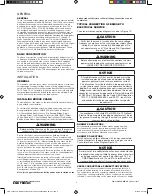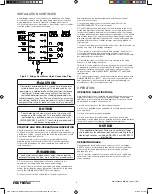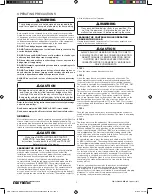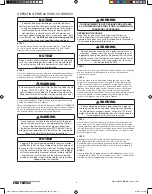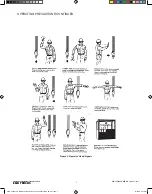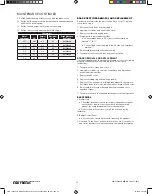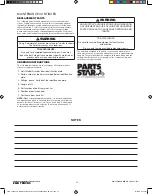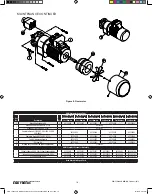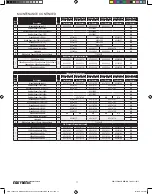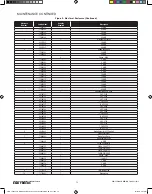
7
8
SINGLE & DOUBLE GIRDER TOP-RUNNING BRIDGES
WITH INDIVIDUAL MOTOR DRIVEN
END TRUCKS
P/N: 11532620 REV. AA
September 2018
WARNING
Never leave an unattended load hanging from the crane.
Load must be safely placed on floor prior to the crane
operator leaving the controls.
When crane is not in use, during the work period, it should be
parked in a safe location, such as the end of the bay or a location
that will not interfere with the movement of people, materials and
equipment. Turn power off to the mainline contactor of the crane.
Store the pendant against a wall or column to prevent damage from
traffic. At the end of the work period or day, park crane as described
herein and turn power off at both disconnects.
RESPONSIBILITY FOR SAFE OPERATION
Each crane operator should be held directly responsible for the safe
operation of his crane. The crane operator should STOP the crane
and refuse to handle loads when:
1. there is any doubt as to SAFETY.
2. any unusual vibrations or sounds are noticed before or when
starting the lift or traverse motions.
3. there are arguments or disagreements with the floor man or
hitchers.
4. the operator feels ill or is not alert.
Overhead cranes are subject to four levels of inspection; Initial, Pre-
Shift, Frequent and Periodical in accordance with the latest editions
of ANSI/ASME B30.2, B30.17 and CMAA 78. These inspections are
necessary to ensure the equipment is safe for use and operating at
its required performance level. Inspection criteria described herein
are general requirements. Specific inspection criteria will be based
on the options and accessories provided with your crane. Refer to
the manufacturer’s maintenance manual for the hoist/trolley and its
specific inspection criteria.
INITIAL INSPECTION
New, re-installed, altered, repaired and modified cranes shall be
inspected prior to initial use. Inspection of all altered, repaired or
modified cranes may be limited to the provisions affected by the
work as determined by a qualified crane technician. Inspections shall
include, but not limited to, clearances, operating speeds, lubrication,
control settings, safety devices, etc. Refer to START UP and PRE-
OPERATIONAL INSPECTION elsewhere in this manual.
PRE-SHIFT INSPECTION
A pre-shift inspection shall be performed by the crane operator or
designated person at the beginning of each shift, or the first time
the crane is used during each shift. This is a visual and operational
inspection to ensure the equipment is in good working order. Items
to be checked include limit switches, brakes, electrical equipment
and all safety devices. Crane is to be operated without a load to
check for any unusual sounds, vibrations, or anything that may be
apparently wrong. Any discrepancies or suspected discrepancies
shall be immediately reported to crane operator’s supervisor. Below
is a check list which can be used for this inspection.
PRE-OPERATION INSPECTION CHECKLIST
Tagged Crane
or Hoist
Check that crane or hoist is not tagged with an
out-of-order sign.
Control Devices
Test run that all motions agree with control
device markings.
Brakes
Check that all motions do not have excessive
drift and that stopping distance is normal.
Hook
Check for damage, cracks, nicks, gouges,
deformations of the throat opening, wear on
saddle or load bearing point, and twist. Refer
to the manual furnished by the original crane
manufacturer.
Hook Latch
If a hook latch is required, check for proper
operation.
Wire Rope
Check for broken wires, broken strands, kinks,
and any deformation or damage to the rope
structure.
Hoist Chain
Check for cracks, nicks, gouges, wear and
stretch-check that the chain is in the upper and
lower sprockets and in the chain guide.
Reeving
Check that the wire rope is properly reeved
and that rope parts are not twisted about each
other.
Limit Switches
Check that the upper limit device stops the
lifting motion of the hoist load block before
striking any part of the hoist or crane.
Oil Leakage
Check for any sign of oil leakage on the crane
and on the floor beneath the crane.
Unusual Sounds
Check for any unusual sounds from the crane
or hoist mechanism while operating the crane
or hoist.
Warning and
Safety Labels
Check that warning and other safety labels are
not missing and are legible.
Housekeeping
and Lighting
Check area for accumulation of material to
prevent tripping or slipping. Also check area for
poor lighting.
OPERATING PRECAUTIONS
INSPECTION
CMK_12322 Yale Rotating Axle End Truck Parts 11532619-REV AD_mec.indd 8
10/16/18 2:07 PM




